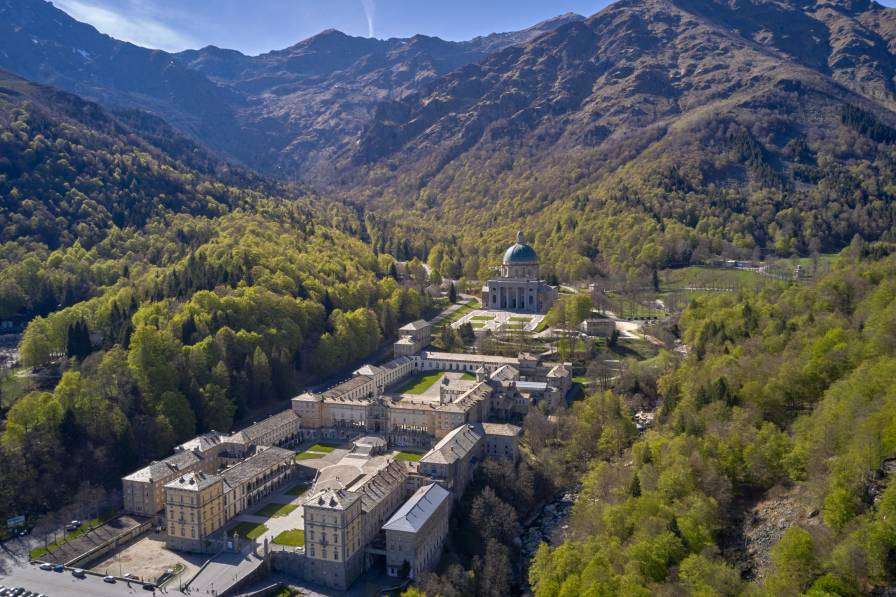

This Marian Sanctuary was previously mentioned in Issue No. 204, within the last installment of the series on the Celebrated Sanctuaries of the Madonna by Fr. Northcote. There it was related that St. Eusebius of Vercelli, when he returned from exile to Italy in 361, brought with him three wooden statues of Our Lady from the East. One of these (according to legend, carved by St. Luke, and found by St. Eusebius in Jerusalem) he deposited at Oropa in a cave or niche in the rocks, to safeguard it against the incursions of the Arians. When an effort was later made to move the image, its weight was supernaturally increased and they had to leave it there, in the mountains, where it currently presides over a massive shrine. Pious believers interpret the supernatural weight of the image to be a sign from the Blessed Virgin Mary that She willed a sanctuary be built there.
Some believe that St. Eusebius himself built a small chapel to house the image. It is certain that a church dedicated to the Blessed Virgin Mary existed there during the Middle Ages. It was replaced in the early 17th century with what is known today as the Ancient Basilica. During the following two centuries, several other buildings were added to the complex, including the royal apartments of the House of Savoy, a massive library and the Royal Gate, a masterpiece designed by the architect Filippo Juvarra in the 18th century. The last addition to the sanctuary was the Upper Basilica, a monumental church built between 1885 and 1960 due to the large number of pilgrims visiting Oropa. It can hold 3,000 people and its dome is 80 meters high.
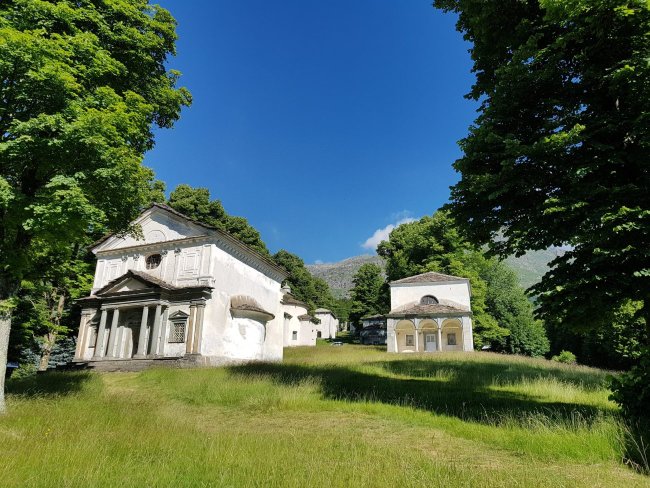
The large sanctuary complex stands at approximately 1200 meters above sea level, in a valley at the foot of a scenic mountain backdrop,
embellished by the two basilicas, the Ancient one and the Upper one, surrounded by large courtyards flanked by buildings and arcades.
Climbing up from the village of Biella, just before reaching the complex, a devotional path opens up on the left, leading to the Sacred Mount and
zigzagging on a grassy slope still used as pasture. The twelve chapels along this path (image above), whose construction was started in the year 1620,
in their interiors tell the life story of the Virgin Mary through polychrome terracotta statues and frescoes by Giovanni d'Enrico and his school,
as well as by Bartolomeo Termine and Agostino Silva, and in the 18th century by Carlo Francesco, Giuseppe Auregio Termine and Giovanni Galliari
(image below – Mary in the Temple). Five additional chapels dedicated to the Saints and the tradition of the Sanctuary are located along the
last stretch of the climb that leads to Oropa from Biella and to the east of the Sacred Mount.
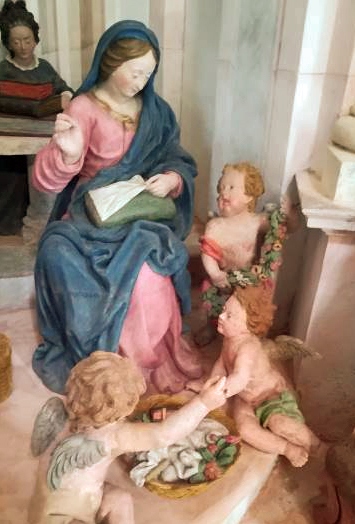
The spiritual heart of the Sanctuary, the 17th century "Ancient Basilica," was built after the City of Biella made a vow on the occasion of the plague epidemic of 1599. In 1620, with the completion of the Church, the first of the solemn coronations of the statue was held – repeated every 100 years, except for the year 2020, when the ceremony was omitted on account of Covid. The façade, designed by the architect Francesco Conti, with its elegant greenish veins of Oropa stone, is ennobled by the portal which bears the Savoy coat of arms of Duke Carlo Emanuele II at the top, supported by two angels. The inscription O quam Beatus, o Beata, quem viderint oculi tui (O how Blessed, O Blessed One, is Him Whom Thy eyes have seen), is carved on the arch of the portal – greeting the pilgrims as they cross the threshold of the Basilica.
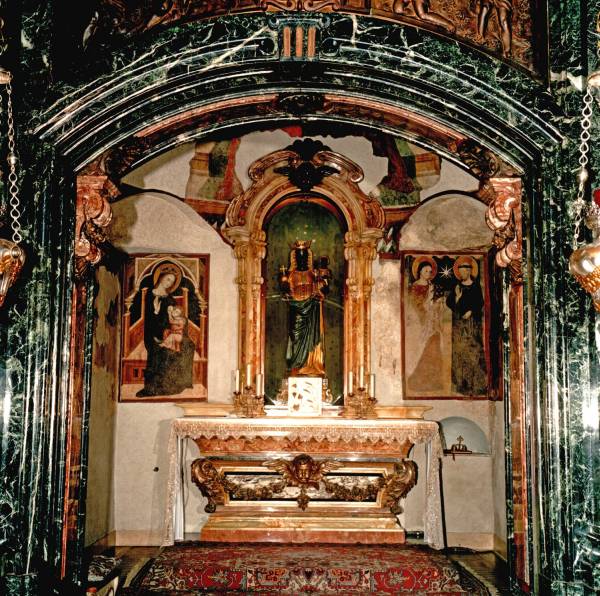 Raised on the site where the ancient church of Our Lady once stood, the Ancient Basilica preserves inside the Sacellum or Chapel of St. Eusebius,
built in the 9th century. Frescoes dating back to the 14th century, the work of an unknown artist, decorate the walls and ceiling of the Sacellum;
they are centered on the Blessed Virgin and some Saints who must have been particularly venerated in the ancient shrine.
Unfortunately, many have been damaged over the centuries.
Raised on the site where the ancient church of Our Lady once stood, the Ancient Basilica preserves inside the Sacellum or Chapel of St. Eusebius,
built in the 9th century. Frescoes dating back to the 14th century, the work of an unknown artist, decorate the walls and ceiling of the Sacellum;
they are centered on the Blessed Virgin and some Saints who must have been particularly venerated in the ancient shrine.
Unfortunately, many have been damaged over the centuries.
The statue of the Black Madonna brought by St. Eusebius, made of the cedar of Lebanon, is kept inside this Chapel. Our Lady and the Christ Child sometimes wear the various crowns bestowed by the coronation ceremonies mentioned above. It is observed that despite its age, the statue has no damage from woodworm; the foot of Our Lady has not been worn from the many touches and kisses it has received from pilgrims; and dust never settles on the faces of the Virgin or the Infant Jesus (image front cover).
One of the additional chapels, called Cappella del Roc (image below), stands in the place where, according to tradition, St. Eusebius first hid the statue amongst the rocks. While the other chapels are on the road leading to the Sanctuary, the Cappella del Roc is on the opposite (eastern) side of the complex. It was built in the first half of the 18th century by the inhabitants of Fontainemore, a locality in the Aosta Valley, still strongly linked to the Sanctuary by the ancient procession that winds its way every five years between the mountains that separate the two valleys.
Like so many other Sanctuaries, Oropa displays the many ex-voto plaques and images, left by grateful pilgrims, in a special gallery. In modern times approximately 800,000 pilgrims and about 100 pilgrimages have visited Oropa annually. According to a local tradition, the town of Biella made a vow during the 17th century plague to make a pilgrimage to Our Lady every year in thanksgiving for being spared. The Feast of Our Lady of Oropa is observed on October 29.
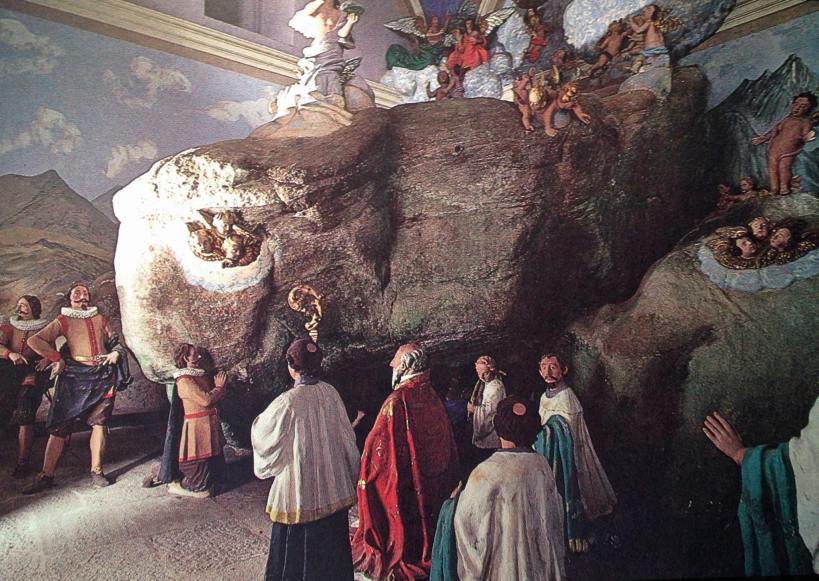
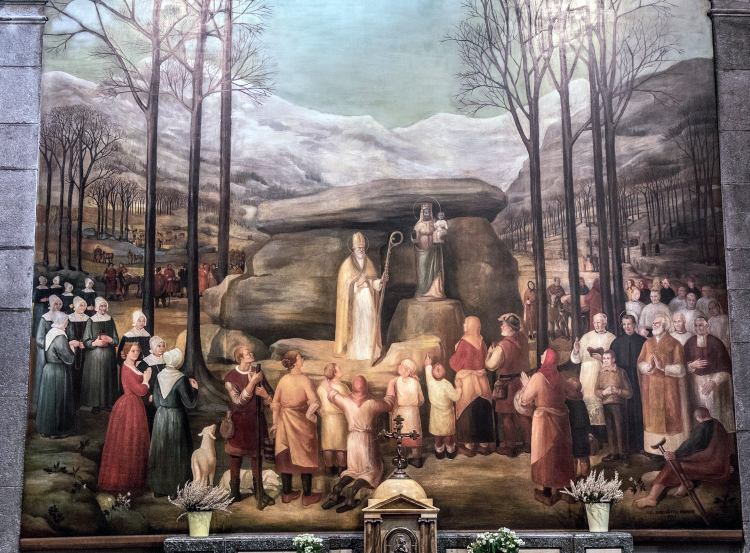
Alphabetical Index; Calendar List of Saints
Contact us: smr@salvemariaregina.info
Visit also: www.marienfried.com